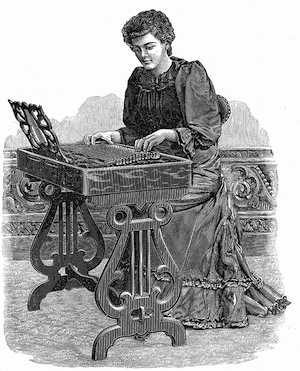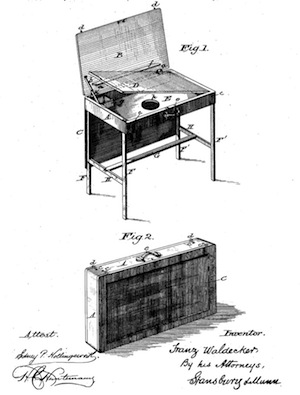In the late 1800s, the zither reached a pinnacle of popularity in the U.S. With so many zither players, creative minds sought to improve the instrument or engineer accessories for playing. The rights to these inventions were secured through the issuance of patents by the United States Patent and Trademark Office. This article presents several of these early zither patents and their respective inventors.

As a founding father of the zither in the United States, Franz Waldecker had many accomplishments. With a music store and instrument factory in Washington, D.C., he found time to write a comprehensive zither method and publish a zither newsletter. He also happens to have been awarded one of the first zither-related patents in the U.S.

Franz Schwarzer table zither, patented 1893
On April 12, 1881, Franz Waldecker was awarded U.S. Patent No. 240,057 for his improved zither table. As every zitherist can attest, a play-day entails packing a zither, music stand, table and bundles of sheet music which when added together, can be quite cumbersome. Franz Waldecker realized this and sought a simpler solution. His patented zither table served a multi-purpose role as a surface for playing, an instrument case and music holder. An excellent idea, although it never seemed to catch on.
In the years after Waldecker's patent, others came forward to lay claim to their creations. On October 26, 1886, America's famous zither maker Franz Schwarzer was issued a patent for his string holder, which he used on his Arion model zithers. Later, on August 8, 1893, he was awarded an additional patent for his table zither. Schwarzer's “zither-with-legs” was designed to be loud, and according to an early advertisement, was "especially adapted for use in large halls and parlors, the resonance being of a nature that requires sufficient distance between audience and the performer, in order to fully appreciate the wonderful characteristic tones which are peculiar to the zither only."
On February 16, 1886, Carl Rahn of Chicago, Illinois, invented a zither attachment that could be used to more easily produce harmonics. This same year, Geremias Osswald, also from Chicago, received a patent for a zither with an additional resonance chamber. In his application, he claimed that his specially constructed zither could double or triple the volume of a typical zither.

Franz Waldecker zither table, patented 1881
Other inventors, possibly motivated by compassion, have sought to alleviate the zither player's discomfort. Claus Van Haagen's 1883 patent features a zither with a modified fretboard. The patented fretboard has longitudinal grooves under the strings with the intent to “relieve the fingers from these severe duties.” On July 30, 1889, Brooklyn, New York, resident John Josef Stoll patented a finger-nail guard to protect the zither player's nail and finger from "abrasions and inflammations."
In the early 1890s, the quest for an improved zither table continued, with patents awarded to Alexander Von Wascinski, of West Hoboken, New Jersey, and to Henry Meyer, of Brooklyn, New York. As with Waldecker's table, the idea of combining a zither table, case and accessories into a single portable unit didn't catch on.
The patents presented in the chart below span the most popular years of zither playing in the U.S. If production at the factory of Franz Schwarzer can be used as a gauge, zither playing in the U.S. plateaued in the early 1890s. Afterwards, production at the factory slowed and a dramatic decline occurred with the outbreak of World War I. Patents related to zithers and their accessories followed a similar trajectory. With fewer players, fewer minds were dedicated to solving the needs and nice-to-haves of a waning zither community.
| Patent Number | Date | Patent Owner | Description |
| 240057 | April 12, 1881 | Franz Waldecker (Washington, District of Columbia) | Zither table |
| 281584 | July 17, 1883 | C. Van Haagen (Collegeville, Pennsylvania) | Instrument finger board |
| 336158 | February 16, 1886 | C. H. Rahn (Chicago, Illinois) | Zither attachment for the production of harmonics |
| 351406 | October 26, 1886 | Franz Schwarzer (Washington, Missouri) | String holder |
| 351710 | October 26, 1886 | G. Osswald (Chicago, Illinois) | Zither with an additional resonance chamber |
| 352648 | November 16, 1886 | C. F. Haupt (Dresden, Germany) | Unique arrangement of the accompaniment strings |
| 408052 | July 30, 1889 | J. J. Stoll (Brooklyn, New York) | Finger nail protector |
| 433801 | August 5, 1890 | H. Meyer (Brooklyn, New York) | Zither table |
| 447948 | March 10, 1891 | G. B. Durkee (Chicago, Illinois) | Instrument bridge for zithers |
| 452361 | May 18, 1891 | J. Charva (New York, New York) | Tail piece for zithers |
| 459603 | September 15, 1891 | W. A. Tuebnée (Baltimore, Maryland) | Mechanic for stringed instruments |
| 466878 | January 12, 1892 | Charles Buckner (San Francisco, California) | Reinforced zither frame |
| 477493 | June 21, 1892 | Vetal Bessier (Brooklyn, New York) | Metal-framed zither with added features |
| 495759 | April 18, 1893 | Gustav Schömig (Vienna, Austria-Hungary) | Pedal zither |
| 502767 | August 8, 1893 | Franz Schwarzer (Washington, Missouri) | Table zither |
| 504071 | August 29, 1893 | A. Von Wascinski (West Hoboken, New Jersey) | Stand and stool for zithers |
| 1111256 | September 22, 1914 | F. Geéb (Long Island City, New York) | Zither finger board |

Do you have a zither-related story that you would like to share? For more information on how to contribute, email dave@zither.us or use the provided contact form.
